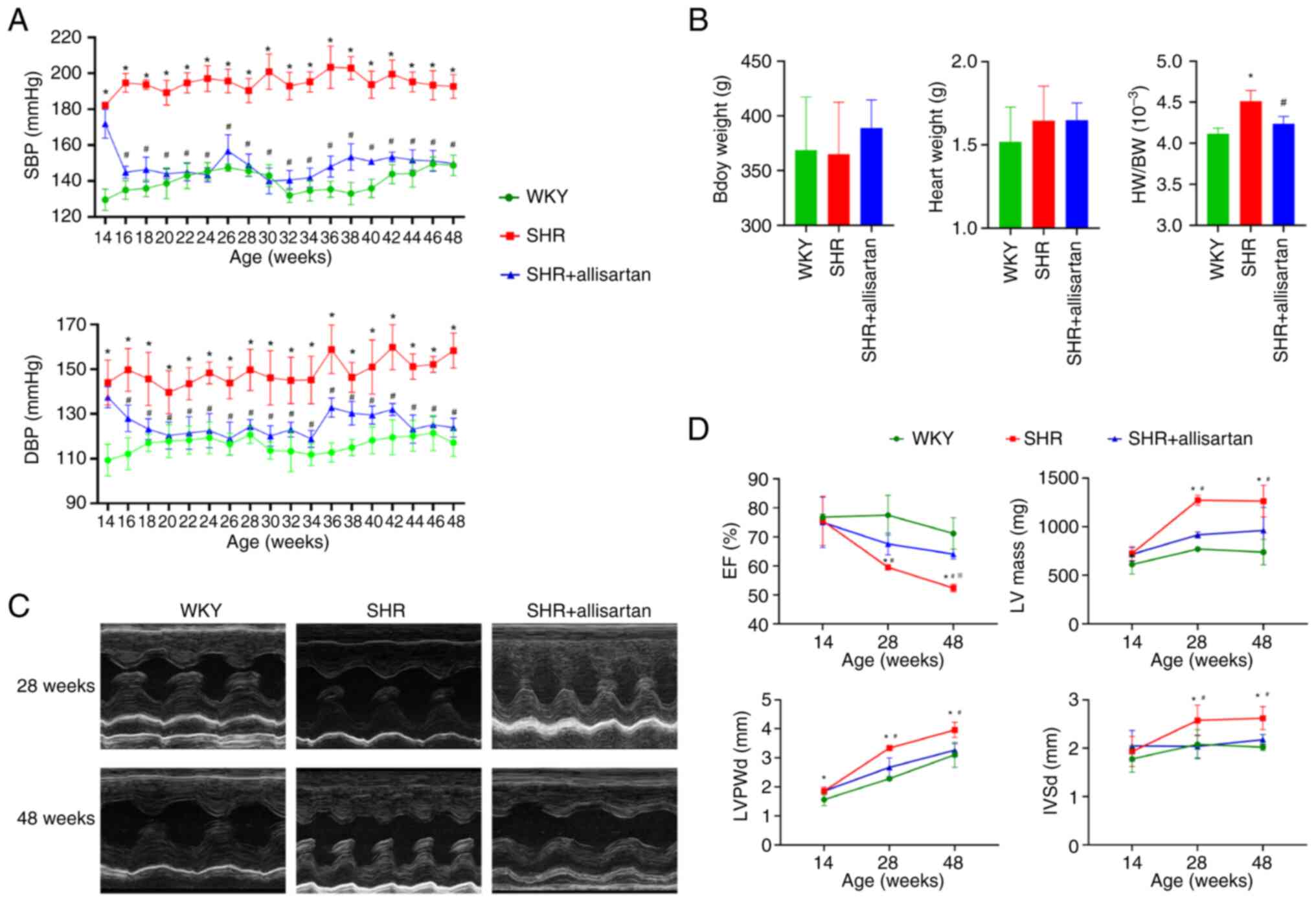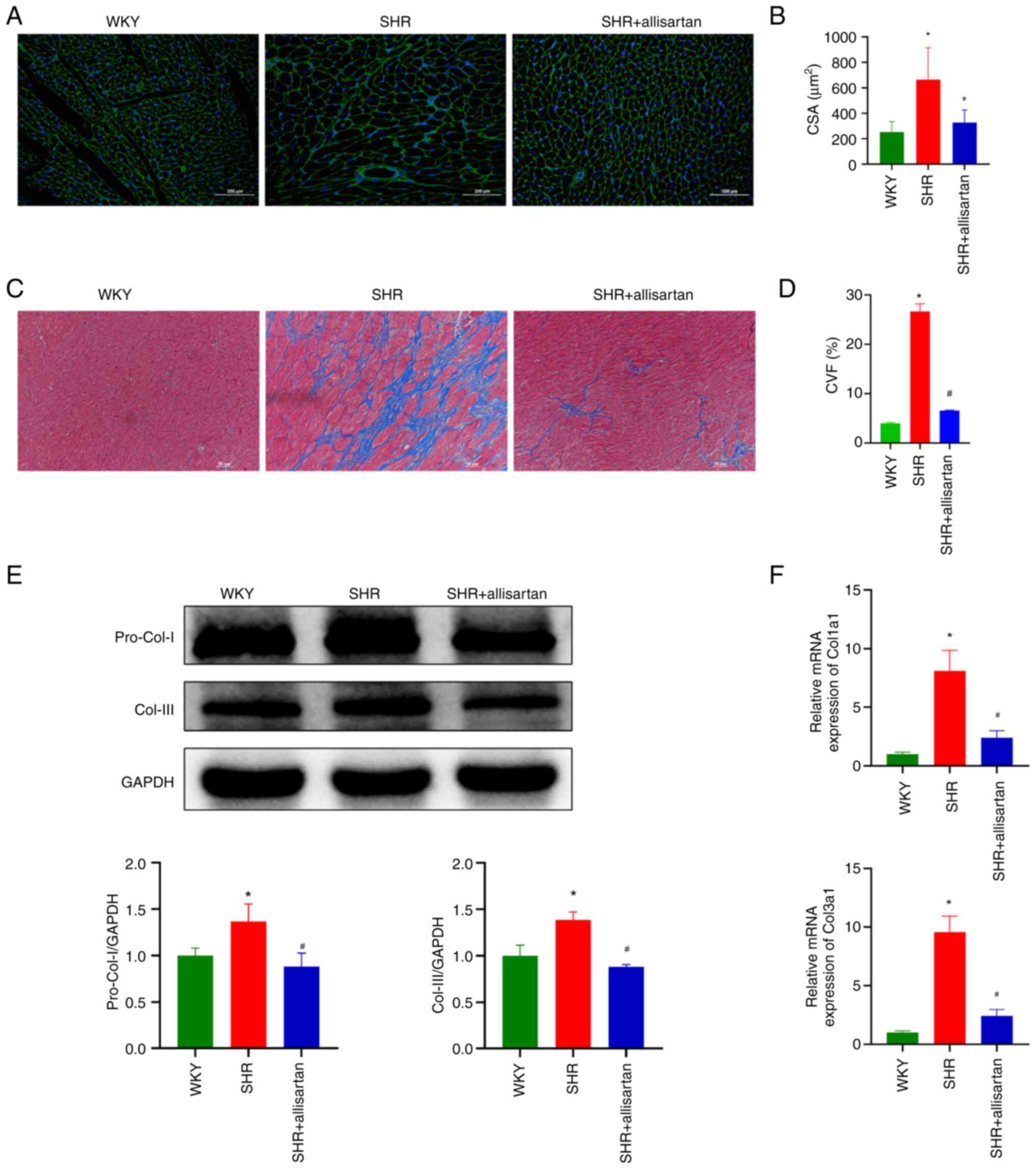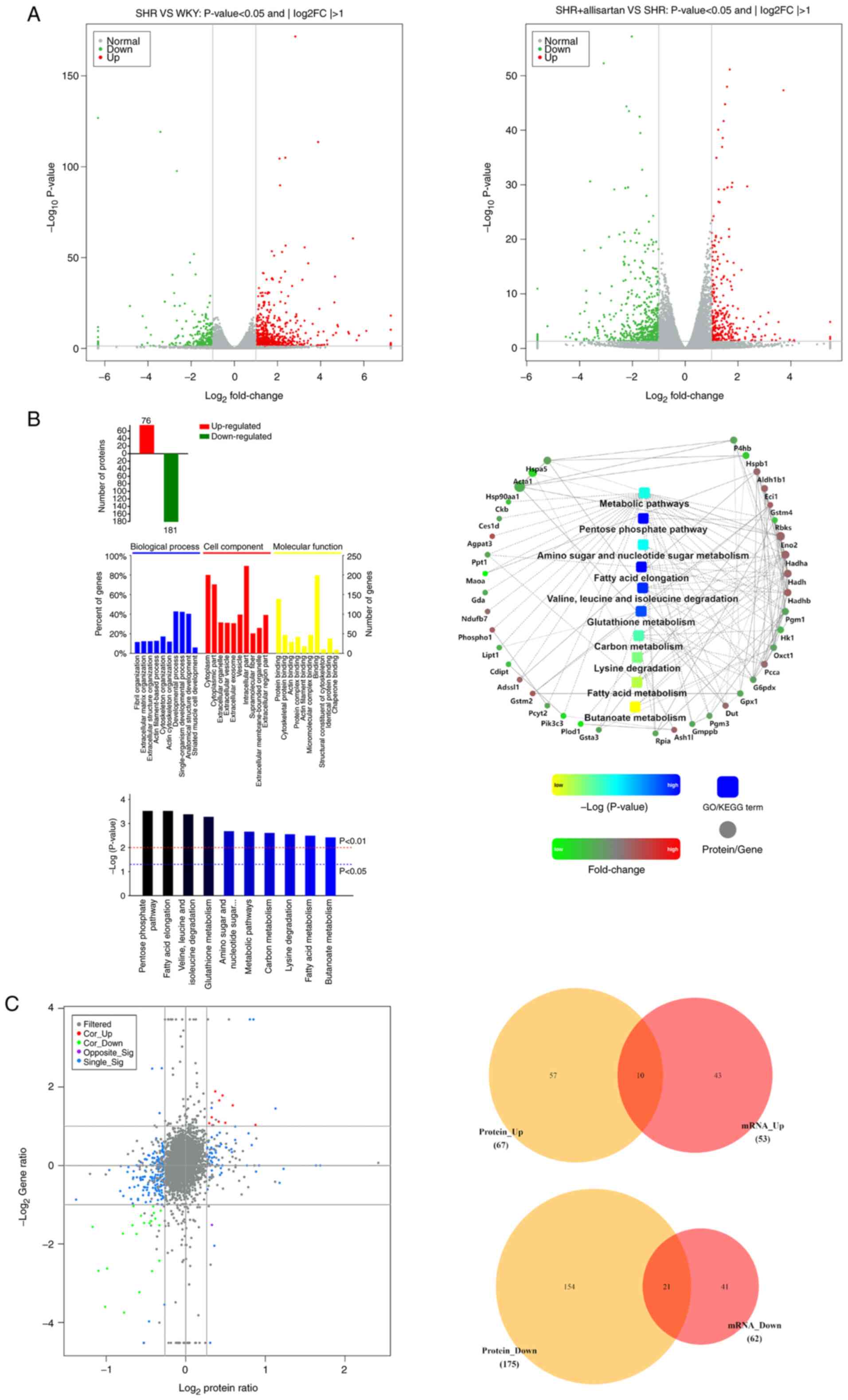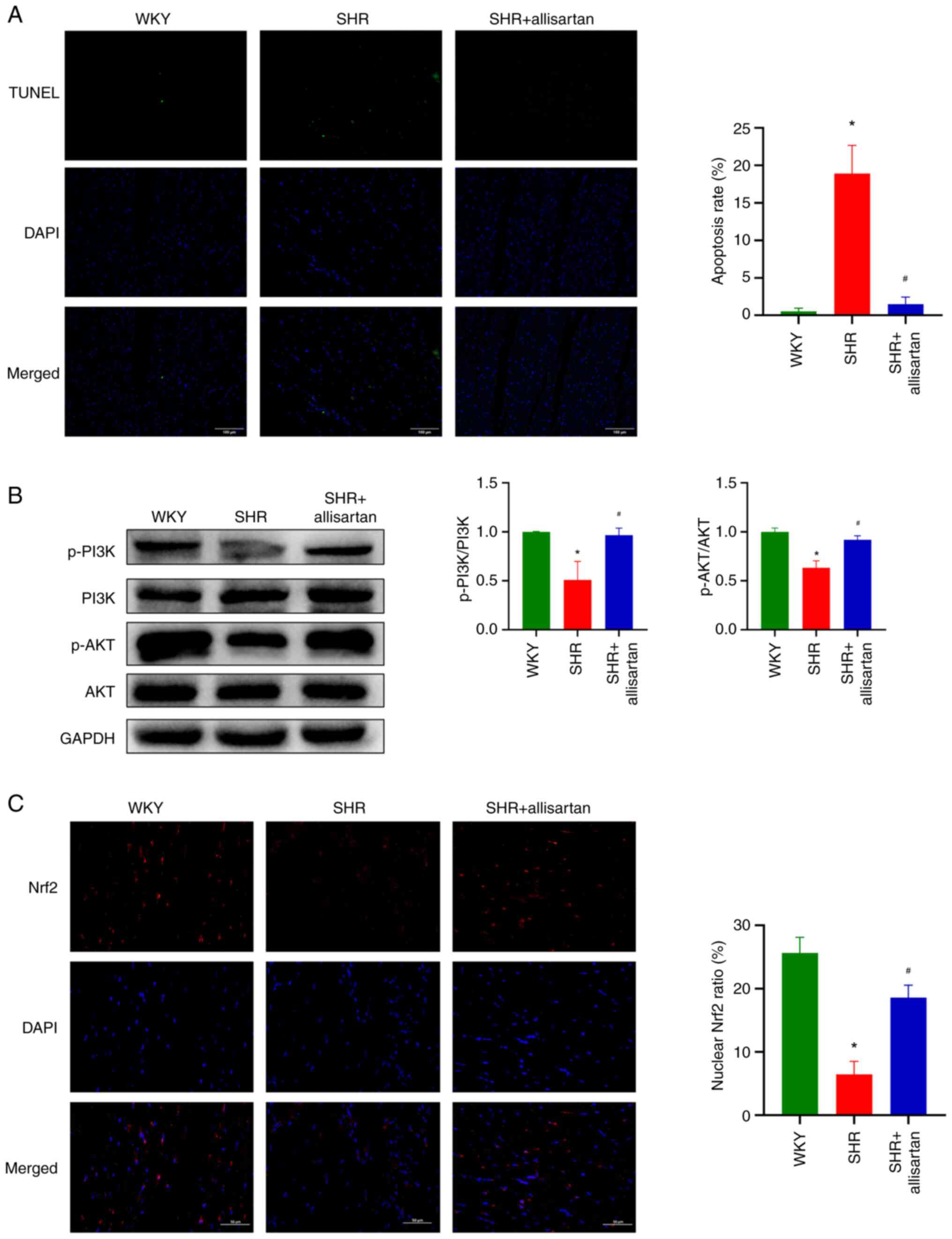|
1
|
Dorans KS, Mills KT, Liu Y and He J:
Trends in prevalence and control of hypertension according to the
2017 American College of Cardiology/American Heart Association
(ACC/AHA) Guideline. J Am Heart Assoc. 7(e008888)2018.PubMed/NCBI View Article : Google Scholar
|
|
2
|
Huang A, Li H, Zeng C, Chen W, Wei L, Liu
Y and Qi X: Endogenous CCN5 Participates in Angiotensin
II/TGF-β1 networking of cardiac fibrosis in high
angiotensin II-induced hypertensive heart failure. Front Pharmacol.
11(1235)2020.PubMed/NCBI View Article : Google Scholar
|
|
3
|
Testai L, Brancaleone V, Flori L,
Montanaro R and Calderone V: Modulation of EndMT by hydrogen
sulfide in the prevention of cardiovascular fibrosis. Antioxidants
(Basel). 10(910)2021.PubMed/NCBI View Article : Google Scholar
|
|
4
|
Ling QS, Zhang SL, Tian JS, Cheng MH, Liu
AJ, Fu FH, Liu JG and Miao CY: Allisartan isoproxil reduces
mortality of stroke-prone rats and protects against
cerebrovascular, cardiac, and aortic damage. Acta Pharmacol Sin.
42:871–884. 2021.PubMed/NCBI View Article : Google Scholar
|
|
5
|
Li X, Sun J, Guo Z, Zhong D and Chen X:
Carboxylesterase 2 and intestine transporters contribute to the low
bioavailability of Allisartan, a Prodrug of Exp3174 for
hypertension treatment in humans. Drug Metab Dispos. 47:843–853.
2019.PubMed/NCBI View Article : Google Scholar
|
|
6
|
Jin Q, Zhu Q, Wang K, Chen M and Li X:
Allisartan isoproxil attenuates oxidative stress and inflammation
through the SIRT1/Nrf2/NF-ԟB signalling pathway in diabetic
cardiomyopathy rats. Mol Med Rep. 23(215)2021.PubMed/NCBI View Article : Google Scholar
|
|
7
|
Writing Committee Members; ACC/AHA Joint
Committee Members. 2022 AHA/ACC/HFSA guideline for the management
of heart failure. J Card Fail. 28:e1–e167. 2022.PubMed/NCBI View Article : Google Scholar
|
|
8
|
Zhang X, Zhao Z, Xu C, Zhao F and Yan Z:
Allisartan ameliorates vascular remodeling through regulation of
voltage-gated potassium channels in hypertensive rats. BMC
Pharmacol Toxicol. 22(33)2021.PubMed/NCBI View Article : Google Scholar
|
|
9
|
Xu C, Zhao Z, Yuan W, Fengping Z, Zhiqiang
Y and Xiaoqin Z: Effect of allisartan on blood pressure and left
ventricular hypertrophy through Kv1.5 channels in hypertensive
rats. Clin Exp Hypertens. 44:199–207. 2022.PubMed/NCBI View Article : Google Scholar
|
|
10
|
Zhou SG, Wang P, Pi RB, Gao J, Fu JJ, Fang
J, Qin J, Zhang HJ, Li RF, Chen SR, et al: Reduced expression of
GSTM2 and increased oxidative stress in spontaneously hypertensive
rat. Mol Cell Biochem. 309:99–107. 2008.PubMed/NCBI View Article : Google Scholar
|
|
11
|
Sies H: Oxidative stress: A concept in
redox biology and medicine. Redox Biol. 4:180–183. 2015.PubMed/NCBI View Article : Google Scholar
|
|
12
|
van der Pol A, van Gilst WH, Voors AA and
van der Meer P: Treating oxidative stress in heart failure: Past,
present and future. Eur J Heart Fail. 21:425–435. 2019.PubMed/NCBI View Article : Google Scholar
|
|
13
|
Huenchuguala S, Muñoz P, Zavala P, Villa
M, Cuevas C, Ahumada U, Graumann R, Nore BF, Couve E, Mannervik B,
et al: Glutathione transferase mu 2 protects glioblastoma cells
against aminochrome toxicity by preventing autophagy and lysosome
dysfunction. Autophagy. 10:618–630. 2014.PubMed/NCBI View Article : Google Scholar
|
|
14
|
Huenchuguala S, Munoz P and Segura-Aguilar
J: The importance of mitophagy in maintaining mitochondrial
function in U373MG cells. Bafilomycin A1 restores
aminochrome-induced mitochondrial damage. ACS Chem Neurosci.
8:2247–2253. 2017.PubMed/NCBI View Article : Google Scholar
|
|
15
|
Hewawasam RP, Liu D, Casarotto MG, Board
PG and Dulhunty AF: The GSTM2 C-Terminal Domain Depresses
Contractility and Ca2+ transients in neonatal rat ventricular
cardiomyocytes. PLoS One. 11(e0162415)2016.PubMed/NCBI View Article : Google Scholar
|
|
16
|
Fafian-Labora JA, Rodriguez-Navarro JA and
O'Loghlen A: Small extracellular vesicles have GST activity and
ameliorate senescence-related tissue damage. Cell Metab. 32:71–86
e5. 2020.PubMed/NCBI View Article : Google Scholar
|
|
17
|
Ndisang JF, Wu L, Zhao W and Wang R:
Induction of heme oxygenase-1 and stimulation of cGMP production by
hemin in aortic tissues from hypertensive rats. Blood.
101:3893–3900. 2003.PubMed/NCBI View Article : Google Scholar
|
|
18
|
Cheng J, Gu W, Lan T, Deng J, Ni Z, Zhang
Z, Hu Y, Sun X, Yang Y and Xu Q: Single-cell RNA sequencing reveals
cell type- and artery type-specific vascular remodelling in male
spontaneously hypertensive rats. Cardiovasc Res. 117:1202–1216.
2021.PubMed/NCBI View Article : Google Scholar
|
|
19
|
Saha P, Mell B, Golonka RM, Bovilla VR,
Abokor AA, Mei X, Yeoh BS, Doris PA, Gewirtz AT, Joe B, et al:
Selective IgA deficiency in spontaneously hypertensive rats with
gut dysbiosis. Hypertension. 79:2239–2249. 2022.PubMed/NCBI View Article : Google Scholar
|
|
20
|
Okamoto K and Aoki K: Development of a
strain of spontaneously hypertensive rats. Jpn Circ J. 27:282–293.
1963.PubMed/NCBI View Article : Google Scholar
|
|
21
|
Kurtz TW and Morris RC Jr: Biological
variability in Wistar-Kyoto rats. Implications for research with
the spontaneously hypertensive rat. Hypertension. 10:127–131.
1987.PubMed/NCBI View Article : Google Scholar
|
|
22
|
Reagan-Shaw S, Nihal M and Ahmad N: Dose
translation from animal to human studies revisited. FASEB J.
22:659–661. 2008.PubMed/NCBI View Article : Google Scholar
|
|
23
|
Liu W, Yu Z, Wang Z, Waubant EL, Zhai S
and Benet LZ: Using an animal model to predict the effective human
dose for oral multiple sclerosis drugs. Clin Transl Sci.
16:467–477. 2023.PubMed/NCBI View Article : Google Scholar
|
|
24
|
National Research Council (US) Committee
for the Update of the Guide for the Care and Use of Laboratory
Animals: Guide for the Care and Use of Laboratory Animals, 8th
edition. National Academies Press (US), Washington, DC, 2011.
|
|
25
|
Kilkenny C, Browne W, Cuthill IC, Emerson
M and Altman DG: National Centre for the Replacement, Refinement
and Reduction of Amimals in Research. Animal research: Reporting in
vivo experiments-the ARRIVE guidelines. J Cereb Blood Flow Metab.
31:991–993. 2011.PubMed/NCBI View
Article : Google Scholar
|
|
26
|
Robinson MD, McCarthy DJ and Smyth GK:
edgeR: A Bioconductor package for differential expression analysis
of digital gene expression data. Bioinformatics. 26:139–140.
2010.PubMed/NCBI View Article : Google Scholar
|
|
27
|
Livak KJ and Schmittgen TD: Analysis of
relative gene expression data using real-time quantitative PCR and
the 2(-Delta Delta C(T)) Method. Methods. 25:402–408.
2001.PubMed/NCBI View Article : Google Scholar
|
|
28
|
Li Y, Yan M, Yang J, Raman I, Du Y, Min S,
Fang X, Mohan C and Li QZ: Glutathione S-transferase Mu
2-transduced mesenchymal stem cells ameliorated anti-glomerular
basement membrane antibody-induced glomerulonephritis by inhibiting
oxidation and inflammation. Stem Cell Res Ther.
5(19)2014.PubMed/NCBI View
Article : Google Scholar
|
|
29
|
Yildiz M, Oktay AA, Stewart MH, Milani RV,
Ventura HO and Lavie CJ: Left ventricular hypertrophy and
hypertension. Prog Cardiovasc Dis. 63:10–21. 2020.PubMed/NCBI View Article : Google Scholar
|
|
30
|
Kemp CD and Conte JV: The pathophysiology
of heart failure. Cardiovasc Pathol. 21:365–371. 2012.PubMed/NCBI View Article : Google Scholar
|
|
31
|
Burchfield JS, Xie M and Hill JA:
Pathological ventricular remodeling: Mechanisms: Part 1 of 2.
Circulation. 128:388–400. 2013.PubMed/NCBI View Article : Google Scholar
|
|
32
|
Shimizu I and Minamino T: Physiological
and pathological cardiac hypertrophy. J Mol Cell Cardiol.
97:245–262. 2016.PubMed/NCBI View Article : Google Scholar
|
|
33
|
Rosca MG, Tandler B and Hoppel CL:
Mitochondria in cardiac hypertrophy and heart failure. J Mol Cell
Cardiol. 55:31–41. 2013.PubMed/NCBI View Article : Google Scholar
|
|
34
|
Fan W, Wang W, Mao X, Chu S, Feng J, Xiao
D, Zhou J and Fan S: Elevated levels of p-Mnk1, p-eIF4E and
p-p70S6K proteins are associated with tumor recurrence and poor
prognosis in astrocytomas. J Neurooncol. 131:485–493.
2017.PubMed/NCBI View Article : Google Scholar
|
|
35
|
Takeuchi CS, Kim BG, Blazey CM, Ma S,
Johnson HW, Anand NK, Arcalas A, Baik TG, Buhr CA, Cannoy J, et al:
Discovery of a novel class of highly potent, selective,
ATP-competitive, and orally bioavailable inhibitors of the
mammalian target of rapamycin (mTOR). J Med Chem. 56:2218–2234.
2013.PubMed/NCBI View Article : Google Scholar
|
|
36
|
Bednarski TK, Duda MK and Dobrzyn P:
Alterations of lipid metabolism in the heart in spontaneously
hypertensive rats precedes left ventricular hypertrophy and cardiac
dysfunction. Cells. 11(3032)2022.PubMed/NCBI View Article : Google Scholar
|
|
37
|
Guan J, Clermont AC, Pham LD, Ustunkaya T,
Revenko AS, MacLeod AR, Feener EP and Simão F: Plasma kallikrein
contributes to intracerebral hemorrhage and hypertension in
stroke-prone spontaneously hypertensive rats. Transl Stroke Res.
13:287–299. 2022.PubMed/NCBI View Article : Google Scholar
|
|
38
|
Luo M, Luo S, Xue Y, Chang Q, Yang H, Dong
W, Zhang T and Cao S: Aerobic exercise inhibits renal EMT by
promoting irisin expression in SHR. iScience.
26(105990)2023.PubMed/NCBI View Article : Google Scholar
|
|
39
|
Ye C, Geng Z, Zhang LL, Zheng F, Zhou YB,
Zhu GQ and Xiong XQ: Chronic infusion of ELABELA alleviates
vascular remodeling in spontaneously hypertensive rats via
anti-inflammatory, anti-oxidative and anti-proliferative effects.
Acta Pharmacol Sin. 43:2573–2584. 2022.PubMed/NCBI View Article : Google Scholar
|
|
40
|
Qiu ZY, Yu WJ, Bai J and Lin QY: Blocking
VCAM-1 ameliorates hypertensive cardiac remodeling by impeding
macrophage infiltration. Front Pharmacol.
13(1058268)2022.PubMed/NCBI View Article : Google Scholar
|
|
41
|
Akazawa H, Yabumoto C, Yano M,
Kudo-Sakamoto Y and Komuro I: ARB and cardioprotection. Cardiovasc
Drugs Ther. 27:155–160. 2013.PubMed/NCBI View Article : Google Scholar
|
|
42
|
Singh KD and Karnik SS: Angiotensin type 1
receptor blockers in heart failure. Curr Drug Targets. 21:125–131.
2020.PubMed/NCBI View Article : Google Scholar
|
|
43
|
Takeuchi F, Liang YQ, Isono M, Ang MY,
Mori K and Kato N: Transcriptomic response in the heart and kidney
to different types of antihypertensive drug administration.
Hypertension. 79:413–423. 2022.PubMed/NCBI View Article : Google Scholar
|
|
44
|
Martinez VR, Martins Lima A, Stergiopulos
N, Velez Rueda JO, Islas MS, Griera M, Calleros L, Rodriguez Puyol
M, Jaquenod de Giusti C, Portiansky EL, et al: Effect of the
structural modification of Candesartan with Zinc on hypertension
and left ventricular hypertrophy. Eur J Pharmacol.
946(175654)2023.PubMed/NCBI View Article : Google Scholar
|
|
45
|
Chen XS, Wang SH, Liu CY, Gao YL, Meng XL,
Wei W, Shou ST, Liu YC and Chai YF: Losartan attenuates
sepsis-induced cardiomyopathy by regulating macrophage polarization
via TLR4-mediated NF-κB and MAPK signaling. Pharmacol Res.
185(106473)2022.PubMed/NCBI View Article : Google Scholar
|
|
46
|
Wu MY, Ma XJ, Yang C, Tao X, Liu AJ, Su DF
and Liu JG: Effects of allisartan, a new AT(1) receptor blocker, on
blood pressure and end-organ damage in hypertensive animals. Acta
Pharmacol Sin. 30:307–313. 2009.PubMed/NCBI View Article : Google Scholar
|
|
47
|
Zhang G, Fan Y, Qiu Y, Zhou Z, Zhang J,
Wang Z, Liu Y, Liu X and Tao J: Allisartan isoproxil improves
endothelial function and vascular damage in patients with essential
hypertension: A single-center, open-label, randomized controlled
trial. Adv Ther. 37:3551–3561. 2020.PubMed/NCBI View Article : Google Scholar
|
|
48
|
Zhang JQ, Yang GH, Zhou X, Liu JX, Shi R,
Dong Y, Chen SB and Li YM: Effects of allisartan isoproxil on blood
pressure and target organ injury in patients with mild to moderate
essential hypertension. Medicine (Baltimore).
98(e14907)2019.PubMed/NCBI View Article : Google Scholar
|
|
49
|
Ma Q: Role of nrf2 in oxidative stress and
toxicity. Annu Rev Pharmacol Toxicol. 53:401–426. 2013.PubMed/NCBI View Article : Google Scholar
|
|
50
|
Lan T, Hu Y, Hu F, Li H, Chen Y, Zhang J,
Yu Y, Jiang S, Weng Q, Tian S, et al: Hepatocyte glutathione
S-transferase mu 2 prevents non-alcoholic steatohepatitis by
suppressing ASK1 signaling. J Hepatol. 76:407–419. 2022.PubMed/NCBI View Article : Google Scholar
|
|
51
|
Sadrkhanloo M, Entezari M, Orouei S,
Zabolian A, Mirzaie A, Maghsoudloo A, Raesi R, Asadi N, Hashemi M,
Zarrabi A, et al: Targeting Nrf2 in ischemia-reperfusion
alleviation: From signaling networks to therapeutic targeting. Life
Sci. 300(120561)2022.PubMed/NCBI View Article : Google Scholar
|
|
52
|
Chanas SA, Jiang Q, McMahon M, McWalter
GK, McLellan LI, Elcombe CR, Henderson CJ, Wolf CR, Moffat GJ, Itoh
K, et al: Loss of the Nrf2 transcription factor causes a marked
reduction in constitutive and inducible expression of the
glutathione S-transferase Gsta1, Gsta2, Gstm1, Gstm2, Gstm3 and
Gstm4 genes in the livers of male and female mice. Biochem J.
365(Pt 2):405–416. 2002.PubMed/NCBI View Article : Google Scholar
|
|
53
|
Saw CL, Yang AY, Guo Y and Kong AN:
Astaxanthin and omega-3 fatty acids individually and in combination
protect against oxidative stress via the Nrf2-ARE pathway. Food
Chem Toxicol. 62:869–875. 2013.PubMed/NCBI View Article : Google Scholar
|
|
54
|
Wang L, Zhao M, Qian R, Wang M, Bao Q,
Chen X, Du W, Zhang L, Ye T, Xie Y, et al: Nicotinamide
mononucleotide ameliorates silica-induced lung injury through the
Nrf2-Regulated glutathione metabolism pathway in mice. Nutrients.
15(143)2022.PubMed/NCBI View Article : Google Scholar
|
|
55
|
Zou W, Chen C, Zhong Y, An J, Zhang X, Yu
Y, Yu Z and Fu J: PI3K/Akt pathway mediates Nrf2/ARE activation in
human L02 hepatocytes exposed to low-concentration HBCDs. Environ
Sci Technol. 47:12434–12440. 2013.PubMed/NCBI View Article : Google Scholar
|
|
56
|
Ali T, Kim T, Rehman SU, Khan MS, Amin FU,
Khan M, Ikram M and Kim MO: Natural dietary supplementation of
anthocyanins via PI3K/Akt/Nrf2/HO-1 pathways mitigate oxidative
stress, neurodegeneration, and memory impairment in a mouse model
of Alzheimer's disease. Mol Neurobiol. 55:6076–6093.
2018.PubMed/NCBI View Article : Google Scholar
|














